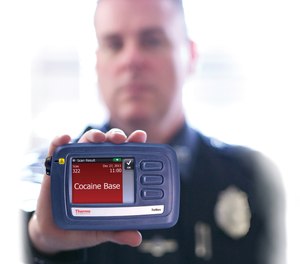By Ron LaPedis
Thank you for reading this post, don't forget to follow and signup for notifications!
In 2021, there were 106,699 drug overdose deaths in the United States, with the rate of deaths involving synthetic opioids other than methadone increasing by 22%, according to the Centers for Disease Control and Prevention. As those individuals addicted to opioids build tolerance, more and more powerful drugs are needed to satisfy their habit.
The emergence of nitazenes


Nitazenes were first developed about 60 years ago from synthetic compounds by researchers working on morphine alternatives. While a patent was obtained, it was abandoned because nitazenes had a high potential for overdose but no legitimate medicinal purpose.
The DEA reports that isotonitazene, a nitazene analog opioid 20 times more potent than fentanyl, has moved into the Southern states and, more recently, along the Eastern seaboard. After being detected in Philadelphia, the Philadelphia Department of Public Health issued a health alert. Researchers have also identified 40 fatal overdoses involving isotonitazene.
Similar to fentanyl and heroin, nitazene analogs are most commonly used intravenously and intranasally via spray or insufflation, but can also be smoked, vaporized or taken sublingually.
Nitazene analogs can appear in a variety of colors and preparations, including yellow, brown, gray, or off-white powders, and are most often sold as “heroin” or “fentanyl” in illicit drug markets. Nitazene analogs are sold online as powders, ready-to-use nasal sprays, or counterfeit pills
Alex Krotulski, associate director at The Center for Forensic Science Research and Education who works to identify emerging drugs, told The Hill that nitazenes are grossly underreported as they are not routinely tested for, and that his lab alone has had at least 1,000 identifications of nitazenes and estimates the drug may account for about 5% of the 100,000 fatal overdoses last year.
“Tranq” or xylazine, a non-opioid veterinary tranquilizer that is not approved for human use, has also been contributing to a growing number of overdose deaths in San Francisco and Los Angeles.
Can you ID that drug?
Law enforcement officials quickly need to identify suspected narcotics in the field to help keep drugs and drug dealers off the streets. Unfortunately, fentanyl test strips cannot detect nitazene analogs, leaving law enforcement in the dark and possibly risking lives.
Just like your computer or car can be updated with the latest software, Thermo Fisher Scientific’s TruNarc Handheld Narcotics Analyzer, a Raman spectrometer used as a presumptive testing tool, can be updated as well. The v1.10 software adds the capability to detect isotonitazene and other nitazene analogs, along with more than 545 suspected controlled substances, in a single, definitive test. Because drug test samples can be scanned directly through plastic or glass, exposure is minimized, contamination is prevented, and evidence is preserved.
Specifically, the new library adds several nitazenes:
- Butonitazene
- Flunitazene
- Isotodesnitazene
- Isotonitazene
- Metodesnitazene
- Metonitazene
- N-Piperidinyl etonitazene
- N-Pyrrolidino etonitazene
- Protonitazene
In addition, the new library adds 10 more fentanyl analogs, plus 6 more norfentanyl precursors and 3 Bucinnazines (AP-237).
Why is this important to you?
Without knowing the exact chemicals you are dealing with, it is hard to trace connections and sources.
With the number of new drugs coming into the illicit marketplace in record time, it is important that whatever technology you use to identify them can be kept updated while maintaining chain of custody and ensuring court-admissible results. To achieve this, the TruNarc includes a “closed loop” library, preventing user modification while allowing manufacturer-supplied updates to be made on a regular basis to ensure users have access to the latest emerging threats.
For more information on Thermo Fisher Scientific’s TruNarc Handheld Narcotics Analyzer, visit thermofisher.com/trunarc.
About the author
Ron LaPedis is an NRA-certified Chief Range Safety Officer, NRA, USCCA and California DOJ-certified instructor, is a uniformed first responder, and frequently writes and speaks on law enforcement, business continuity, cybersecurity, physical security and public/private partnerships.


